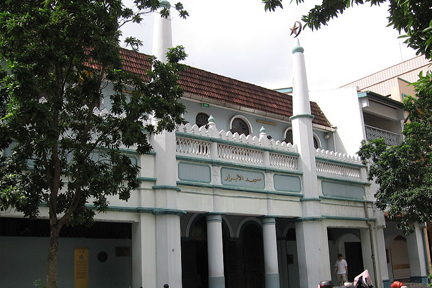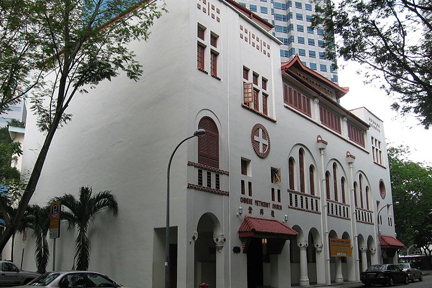Telok Ayer Street, was named after Telok Ayer Bay, located at the foot of Mount Wallich. The Malay name refers to "bay water" because Telok Ayer Street was the coastal road along the bay.
Telok Ayer Street appears in George Drumgoole Coleman's 1836 Map of Singapore as Teluk Ayer Street. The Chinese name for Telok Ayer Street refers to the Chinese temple on this street – da bo gong miao jie.
Telok Ayer Street was also known colloquially under two names. The area nearer Merchant Street was called Guan Soon Street because there was a firm located here called Chop Guan Soon that brought in Indian labourers. Guan Sun is also the name of one of the five divisions of Hoklos (Hokkien) which took part in the Chingay procession once every three years.
The other colloquial name for Telok Ayer Street is called the "front street" of Mah Cho Temple in Hokkien because the street is in front of the Thian Hock Keng Temple, dedicated to Goddess of the Sea, Mah Cho or Matsu.
Telok Ayer Street appears in George Drumgoole Coleman's 1836 Map of Singapore as Teluk Ayer Street. The Chinese name for Telok Ayer Street refers to the Chinese temple on this street – da bo gong miao jie.
Telok Ayer Street was also known colloquially under two names. The area nearer Merchant Street was called Guan Soon Street because there was a firm located here called Chop Guan Soon that brought in Indian labourers. Guan Sun is also the name of one of the five divisions of Hoklos (Hokkien) which took part in the Chingay procession once every three years.
The other colloquial name for Telok Ayer Street is called the "front street" of Mah Cho Temple in Hokkien because the street is in front of the Thian Hock Keng Temple, dedicated to Goddess of the Sea, Mah Cho or Matsu.
Today
Today, the whole bay area in front of Telok Ayer Street lies on reclaimed land. In 1863, a group of local businessmen including Whampoa, applied to the Governor Orfeur Cavenagh for permission to build, at their own expense, a pier and a seawall to reclaim land to build warehouses. However, the request was not acceded, and the Hokkien temple of Thian Hock Keng was to remain fronting the sea until 1879.
Plans for reclamation were again put forward in 1865 and reclamation work carried out between 1878 and 1885. The government levelled the hills along the coast, including Mount Wallich, to reclaim land from Telok Ayer Bay. Robinson Road and Anson Road were subsequently built. The existing marshland was drained, the nutmeg plantations made way for maritime buildings and Thian Hock Keng Temple found itself five blocks away from the sea.
wikipedia
Plans for reclamation were again put forward in 1865 and reclamation work carried out between 1878 and 1885. The government levelled the hills along the coast, including Mount Wallich, to reclaim land from Telok Ayer Bay. Robinson Road and Anson Road were subsequently built. The existing marshland was drained, the nutmeg plantations made way for maritime buildings and Thian Hock Keng Temple found itself five blocks away from the sea.
wikipedia
Nearby

Fuk Tak Chi Temple 福德祠 (Museum)
The Fuk Tak Chi Museum is now part of a sleek boutique hotel’s premises.



